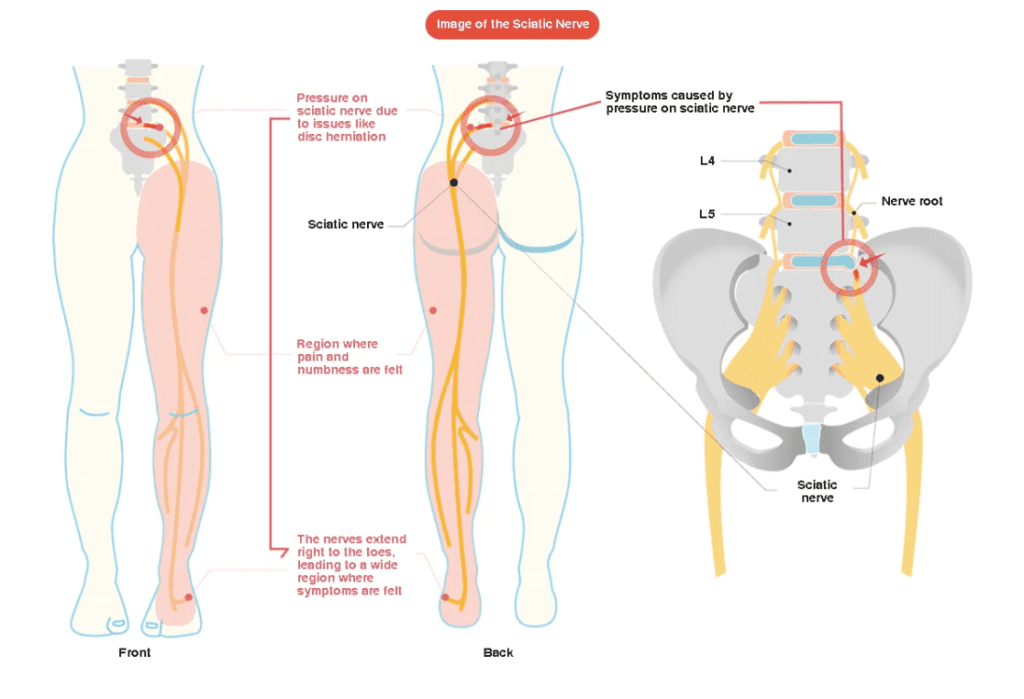July 19, 2024
Patients who suffer from back pain often also suffer from leg pain and numbness in the lower extremities.
In this article, we will discuss sciatica.
What is sciatica?
Sciatica is not the name of a disease, but of a symptom.
The sciatic nerve is the thickest and longest nerve in the human body, running from the lower back to the tip of the foot.
Inflammation of the sciatic nerve causes numbness and pain in the buttocks, thighs, shins, and calves. This is called sciatica.

Causes of Sciatica
Many conditions can cause inflammation of the sciatic nerve, among them lumbar disc herniation, lumbar spinal canal stenosis, intervertebral arthritis, piriformis syndrome, and sacroiliac joint disorders. The most common of these are spinal canal stenosis and disc herniation.
Sciatic nerve pain caused by disc herniation
Herniated lumbar discs are most common in people in their 20s, followed by those in their 30s and 40s, and then younger people in their teens.
The disc collapses and protrudes, causing pressure on the lumbar nerves and resulting in sciatic nerve pain.
Sciatica caused by spinal canal stenosis
Lumbar spinal canal stenosis is a common condition in middle-aged and older people over the age of 50, but some people with originally narrow spinal canals can also have symptoms as early as in their 30s and 40s.
As the spinal canal narrows with age, nerve roots and the cauda equina nerve are compressed, resulting in sciatica.
Symptoms of Sciatica
Symptoms of sciatica often appear in the buttocks and thighs from the waist down. The pain occurs from the buttocks to the lower extremities where the sciatic nerve runs, most often in one limb, but it can also be present in both limbs.
Sciatica is suspected when one or more of the following symptoms are present:
![]() Pain from the buttocks to the lower extremities
Pain from the buttocks to the lower extremities
![]() Difficulty standing for long periods of time
Difficulty standing for long periods of time
![]() Pain or numbness in the lower extremities when bending over
Pain or numbness in the lower extremities when bending over
![]() Pain in the buttocks making it difficult to remain seated for too long
Pain in the buttocks making it difficult to remain seated for too long
![]() The act of walking causes pain in the lower extremities, preventing the patient from walking for too long, but that ability returns after some rest
The act of walking causes pain in the lower extremities, preventing the patient from walking for too long, but that ability returns after some rest
![]() The pain is more pronounced when bending over
The pain is more pronounced when bending over
Treatment of Sciatica
The treatment of sciatica often begins by a symptomatic treatment to relieve the symptoms, regardless of the underlying condition causing the pain. If the pain does not get better with conservative treatment, or if the pain persists for a long period of time and interferes with urination or stool excretion, surgical treatment may be considered.
Our clinics usually perform the Cellgel method on herniated discs with sciatica, and the Florence and Q-Florence methods on spinal canal stenosis with sciatica.
The Cellgel Method
The Cellgel method is a treatment for repairing damaged intervertebral discs.
A drug is injected to fill the cracks in the disc, which then forms a gel that replaces the cracks, preventing further disc degeneration and providing a fundamental treatment.
It is characterized by the fact that the volume of the disc is not reduced, and the drug remains in the disc as a gel-like implant after treatment, thus preserving the disc.
The Cellgel Method is indicated for both lumbar and cervical disc degeneration.

The Florence Method
The Florence method is indicated when disc degeneration is more advanced and spinal canal stenosis or spondylolisthesis are also present.
Special spacers are placed between the spinous processes of the lumbar spine to stabilize the vertebral body while maintaining spinal rotation and flexion, widening the spinal canal and reducing the protrusion of the disc and the thickening of the ligamentum flavum. The narrowed spinal canal is widened, thereby eliminating pain, numbness, and other symptoms.

The Q Florence Method
The Q Florence procedure is a low-risk, minimally invasive treatment for spinal canal stenosis, spondylolisthesis, and lumbar instability.
A specialized device is percutaneously inserted to stabilize an unstable spine and widen the narrowed spinal canal, thereby curing spondylolisthesis.
The Q Florence Method (page in Japanese)

If you are suffering from sciatica, please consider coming to our clinic for a consultation.
About the author of this article

Dr. Tadaaki Minowa, Orthopedic Surgeon
Academic Affiliations and Qualifications
The Japan Society of Low Back Pain
Japanese Society of Endoscopic Surgery
Japan Medical Association Certified Industrial Physician
Japanese Organization of Medical Examiners for Cancer Therapy, Board Certified in Cancer Therapy
Certified physician for the Cellgel method
Certified physician for ozone therapy
Certified physician for the Florence method



